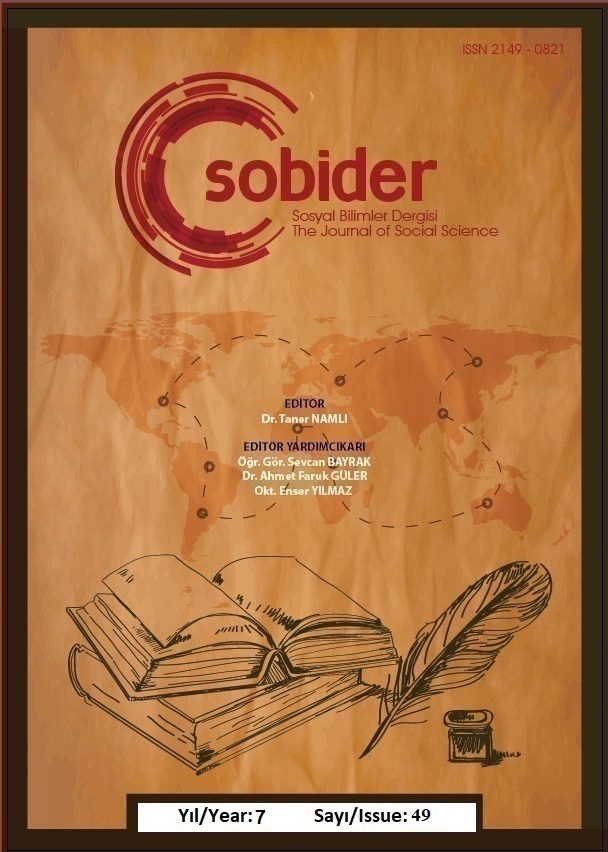Author :
Abstract
Dünyanın her yerinde insanoğlu az çok örtünmeye ihtiyaç duyar. Hemen her toplumda en azından “edep yerlerinin gizlenmesi” şeklinde olmuştur. İnsanın temel ihtiyaçlarından biri olan giyim, çoğu zaman toplumun kültürel yapısının etkisiyle temel ihtiyaç olmanın ötesinde anlamlar kazanmıştır. Tabii olarak insanlar bu örtünme zorunluluğunu daha da geliştirerek zevk haline getirmiş, her toplum kendi kültürüne ve medeniyetine uygun hale getirmeye çalışmıştır. Osmanlı sultanlarının kaftanları, elbise, sarık ve kumaşları gücün, statünün ve zenginliğin göstergesi olmuştur. Özellikle kaftanlar, kumaşları ve desenleri ile her biri şaheser sanat eseridir.Birçok araştırmaya göre basit bir forma sahip olmasına rağmen, Osmanlı kaftanları çok ihtişamlı bir görünüme ve güzelliğe sahiptir. Form ve kalıp özellikleri, dikişle yapılan süslemeler, astar ve pervaz süslemeleri, kürkle yapılan süslemeler, düğmelerle yapılan süslemeler mükemmeldir. Bu kaftanlar, kumaşıyla, motifiyle, ihtişamıyla tüm dünyanın hayranlığını uyandırmış, yerli, yabancı çeşitli müzelerde sergilenmiş ve korunmuş olan bu kaftanlarla ilgili birçok araştırma yapılmıştır.Topkapı Sarayı Müzesi Padişah Giysileri Arşivi’nde bulunan padişah giysileri yaklaşık 2500 parçadan oluşmaktadır. Bunların çoğunu hilat, kaftan ve şalvarlar oluşturmaktadır. Ayrıca az olmakla birlikte çocuk(şehzade) giysileri de vardır, fakat gelenekten dolayı kadın giysileri yoktur. Burada Fatih Sultan Mehmet’e ait 21 adet kaftan, Kanuni Sultan Süleyman’a ait 77 adet kaftan, I. Ahmet’e ait 13 adet kaftan, II. Osman’a ait 30 adet kaftan, IV. Murat’a ait 27 adet kaftan bulunduğu bilinirken, Fatih Sultan Mehmet’ten önceki altı hükümdara ait kaftanlar ismen belirtilmemiştir.Bizde bu çalışmamızda, Başbakanlık Osmanlı Arşivleri, Topkapı Sarayı Müzesi Arşiv Defterlerindeki, padişah elbiseleri için harcanan paralar, padişahın kendisi için divandan alınması gereken çuka ve elbiseler; bâbü’s-sâ’de ağaları ve oradaki görevli kişilerin müstehak oldukları bayramlık hediye kaftân, sârık ve değerleri, babü’s-sa’âde ağalarının müstehak oldukları elbise ve değerleri üzerinde duracağız.
Keywords
Abstract
All over the world, human beings need more or less covering. In almost every society, it has been at least in the form of "hiding their decency". Clothing, which is one of the basic needs of human beings, has gained meaning beyond being a basic need, mostly with the effect of the cultural structure of the society. Naturally, people developed this necessity of veiling and made it a pleasure, every society tried to make it suitable for its own culture and civilization. Especially caftans, fabrics and patterns, each of them is a masterpiece of art.Although it has a simple form according to many studies, Ottoman caftans have a very magnificent appearance and beauty. The form and pattern features, stitched ornaments, lining and molding decorations, fur trimmings, and buttons are all perfect. These caftans have aroused the admiration of the whole world with their fabric, motif and splendor, and many researches have been done on these caftans, which have been exhibited and preserved in various local and foreign museums.The sultan's clothes in the Topkapı Palace Museum Sultan's Clothes Archive consist of approximately 2500 pieces. Most of these are hil'at, caftans and shalwars. In addition, there are children (prince) clothes, although they are rare, but there are no women's clothes due to tradition. Here, 21 caftans belonging to Fatih Sultan Mehmet, 77 caftans belonging to Suleiman the Magnificent, 13 caftans belonging to Ahmet I, II. 30 caftans belonging to Osman, IV. While it is known that there were 27 caftans belonging to Murat, the caftans belonging to six rulers before Fatih Sultan Mehmet were not mentioned by name.In this study, in our study, the money spent for the sultan's clothes in the Archives of the Prime Ministry Ottoman Archives, Topkapı Palace Museum, the coqqa and clothes that should be taken from the council for the sultan himself, the babu's-sâ'de aghas and the festive gifts kafthan, sarık and their values, We will focus on the dress and values that babü's-sa'âde aghas deserve.
Keywords
- Açıkgöz-Ünyay, Fatma, (2012). XVII. Yüzyılda Osmanlı Devletinde Hediye ve Hediyeleşme( Padişahlara Sunulan ve Padişahların Verdiği Hediyeler Üzerine Bir Araştırma), Gazi Üniversitesi, Sosyal Bilimler Enstitüsü, Tarih Ana Bilim Dalı, Yayınlanmamış Doktora Tezi, Ankara.
- Açıkgöz Ünyay, Fatma, (2017), Osmanlı-Avusturya İlişkilerinden Bir Kesit:Amaç Barış- Araç Hediye (Xvıı. Yüzyıl, Socıal Scıences Studıes Journal, Vol:3, Issue:6 pp.894-911.
- Açıkgöz Ünyay, Fatma, (2018), Osmanlılar İle Hindistan Sultanlıkları Arasındaki Diplomatik İlişkiler Ve Hediyeleşme (Xv.-Xvıı. Yüzyıllar), ulakbilge, Cilt 6, Sayı 31, Volume 6, Issue 31.
- Açıkgöz Ünyay, Fatma, (2018), Osmanlı Devleti’nde Pîşkeş (XVII. Yüzyıl) Turkish Studies History, Volume 13/24, p. 287-300.
- Altay, Fikret, (1979), Kaftanlar, İstanbul: Tifdruk Matbaacılık, Topkapı Sarayı Müzesi:3 Yapı Kredi Kültür Sanat Hizmeti.
- Altındağ, Ülkü, (1994), Dârüssaâde, TDVİA, İstanbul, C. 9, s. 1-3.
- Atik, Kayhan, (2019), Osmanlı Bürokratlarının Padişaha Sunduğu Hediyeler, Uluslararası Sosyal Araştırmalar Dergisi / The Journal of International Social Research Cilt: 12 Sayı:
- Bilgin, Arif, (2016), Harc-ı Hâssa Emini, İstanbul, C. EK-1, s. 535-536.
- Çalık, Sıddık, (1993) 1108 Numaralı Harc-I Hassa Defteri’nin Transkripsiyonu ve Değerlendirmesi, İstanbul Üniversitesi, Sosyal bilimler Enstitüsü, Türk İktisat Tarihi Anabilim Dalı, Yüksek Lisans Tezi, İstanbul.
- Eyice, Semavi, (1991), Bâbüssaâde, TDVİA, İstanbul, C. 4, s. 408-409.
- İpşirli, Mehmet, (2006), Musâhib, TDVİA, İstanbul, C. 31, s. 230-231.
- Karaca, Filiz, (2000), İn’âm, , TDVİA, İstanbul, C. 22, s. 259-260.
- Ok, Meltem, (2015), Tasarım Ve Süsleme Öğeleriyle Topkapı Sarayı Padişah Kaftanları, Akdeniz Sanat Dergisi, Cilt 8, Sayı 16, s. 70-85.
- Özen, Mine Esiner (1982). Türkçe'de Kumaş Adları. Tarih Dergisi, sayı 33.
- Reindl-Kiel, Hedda (2007). Osmanlı’da Hediye (16.-17. Yüzyıl). Hediye Kitabı. Haz. Emine Gürsoy Naskali, Aylin Koç, İstanbul: Kitabevi Yayınları.
- Sahillioğlu, Halil, (1993), Ceyb-i Hümayun, TDVİA, İstanbul, C. 7, s.465-467.
- Uzunçarşılı, İmail Hakkı, (1988), Osmanlı Devleti’nin Saray Teşkilatı, Ankara.
- İpşirli, Mehmet, (1995), Enderun, TDVİA, C. 11, s. 185-187.
- İnalcık, Halil, (2001), TDVİA, Kanun, İstanbul, C. 24.
- Pakalın, Mehmet Zeki, (1993), Osmanlı Tarih Deyimleri Ve Terimleri Sözlüğü, C. I, İstanbul.





